1993 CHEVROLET CORVETTE tire pressure
[x] Cancel search: tire pressurePage 113 of 370
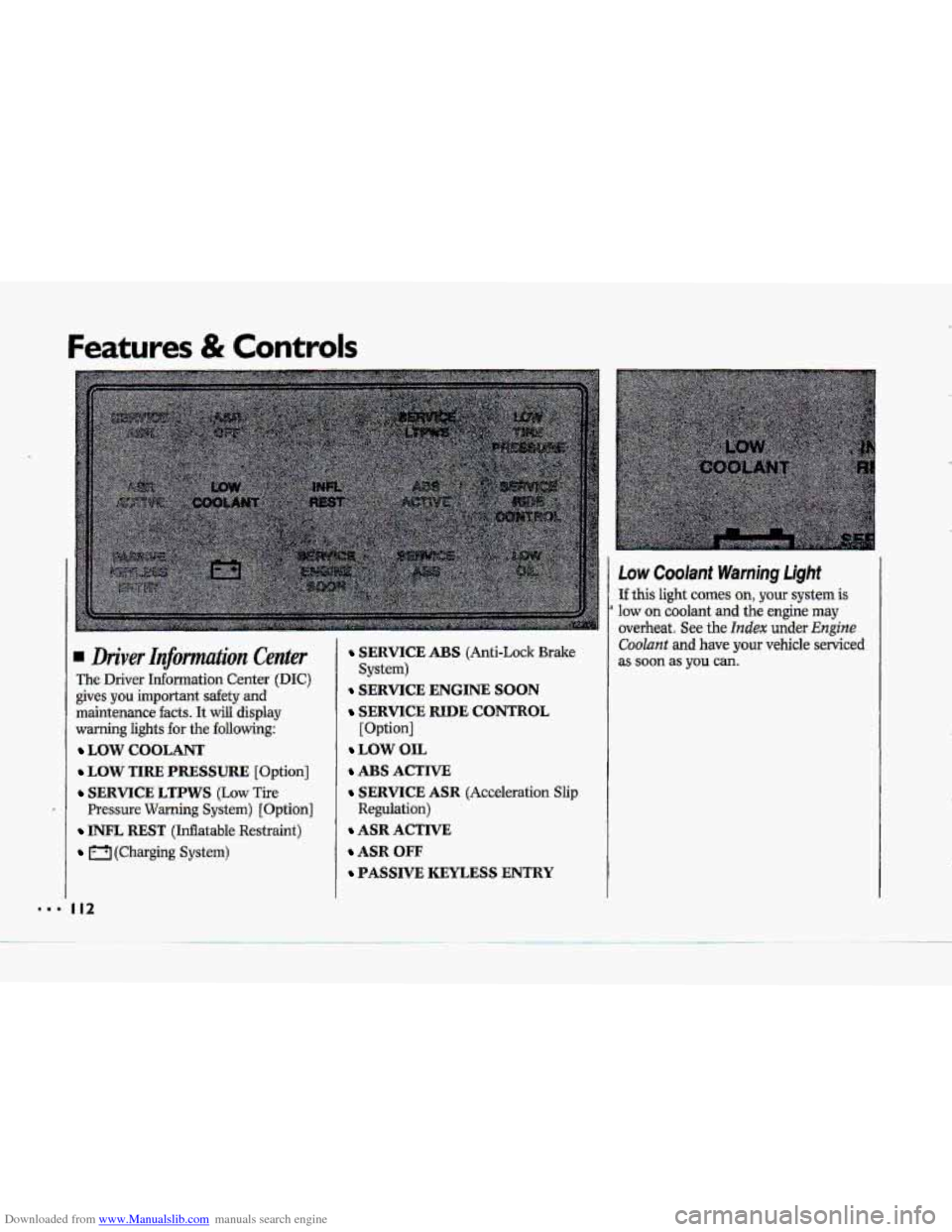
Downloaded from www.Manualslib.com manuals search engine Features & Controls
..I I
Low Coolant Warning Light
If this light comes on, your system is
overheat. See the Index under Engine
Coolant and have your vehicle serviced
a low on coolant and the engine may
Driver Infomtation Center
The Driver Information Center (DIC)
gives you important safety and
maintenance
facts. It will display
warning lights
€or the following:
LOW COOLANT
LOW TIRE PRESSURE [Option]
SERVICE LTPWS (Low Tire
Pressure Warning System) [Option]
INFL REST (Inflatable Restraint)
(Charging System)
I12
SERVICE ABS (Anti-Lock Brake
SERVICE ENGINE SOON
SERVICE RIDE CONTROL
[Option]
LOW OIL
ABS ACTIVE
SERVICE ASR (Acceleration Slip
Regulation)
ASR ACTIVE
ASR OFF
PASSIVE KEYLESS ENTRY
System) as soon as you can.
Page 114 of 370
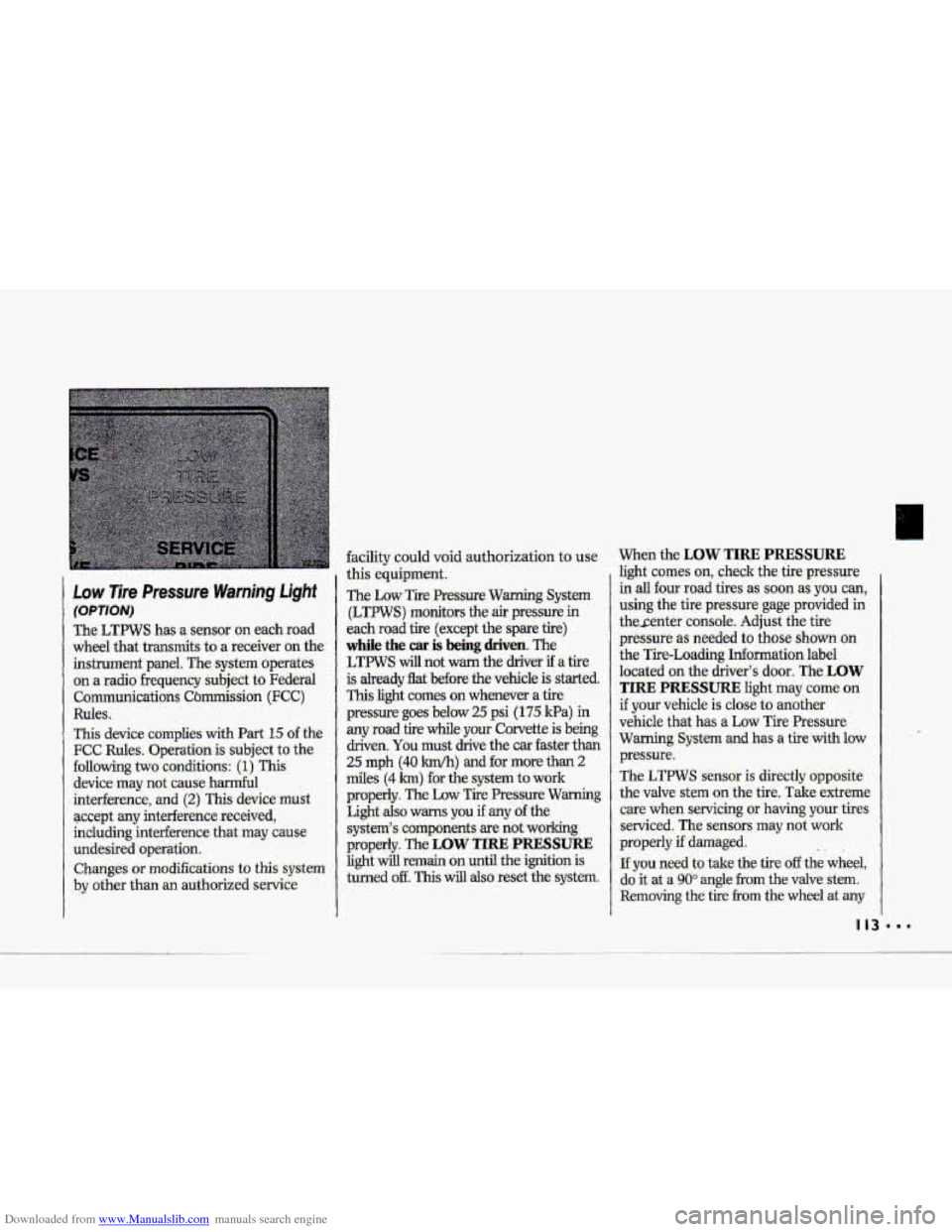
Downloaded from www.Manualslib.com manuals search engine P
Low 7ire Pressure Warning Light
(OPTION)
The LTPWS has a sensor 'on each road
wheel that transmits-to
a receiver on the
instrument panel.
The system operates
on a radio frequency subject
to Federal
Communications Cbmission
(FCC)
Ruks.
This device complies with Part 15 of the
FCC Rules. Operation is subject to the
following
two conditions: (1) This
device may not cause harmful
interhence,
and (2) This device.must
accept
any interhence received,
including interference that-may cause
undesired operation.
Changes or modifications to- this system
by other than an authorized service
facility could void authorization to use
this equipment.
The Low Tre Pressure Warning System
(LTPWS) monitors the
air pressure in
each road tire (except the spare tire)
while the car is being driven. The
LTFWS will not warn the driver if a tire
is
already flat before the vehicle is started.
This light comes on whenever a tire
pressure
goes below 25 psi (I 75 Ha) in
any road tire while your Corvette is being
driven.
You must drive the car faster than
25 mph (40 km/h) and for more than 2
miles (4 h) -for the system to work
properly.
The Low Tire Pressure Warming
Light also warns you if any of the
system's comp.onents-are not working
properly. The
LOW TIRE PRESSURE
light will remain on until the ignition is
turned
off. This will also reset the system.
When the LOW TIRE PRESSURE
fight comes on, check the tire -pressure
.in
all four road tires as soon as you can,
using the
tire pre:ssure gage.provided in
thesenter console. Adjust the tire
pressure as needed to those shown on
the Tire-Loading Information label
10-cated
on the driver's door, The LOW
TIRE PRESSURE light may come on
if your vehicle is close to aaother
vehicle that has
a Low Tire Pressure
Warning System
and has a tire-with low
pressure.
The LTPWS sensor is directly opposite
the valve stem on the tire. Take extreme
care when servicing or
having your tires
serviced. The sensors may not work
properly
if damaged.
If you need to take the tire off the wheel,
do it at a
90" angle from the valve stem.
Removing the tire from the wheel at any
.. 1
Page 115 of 370
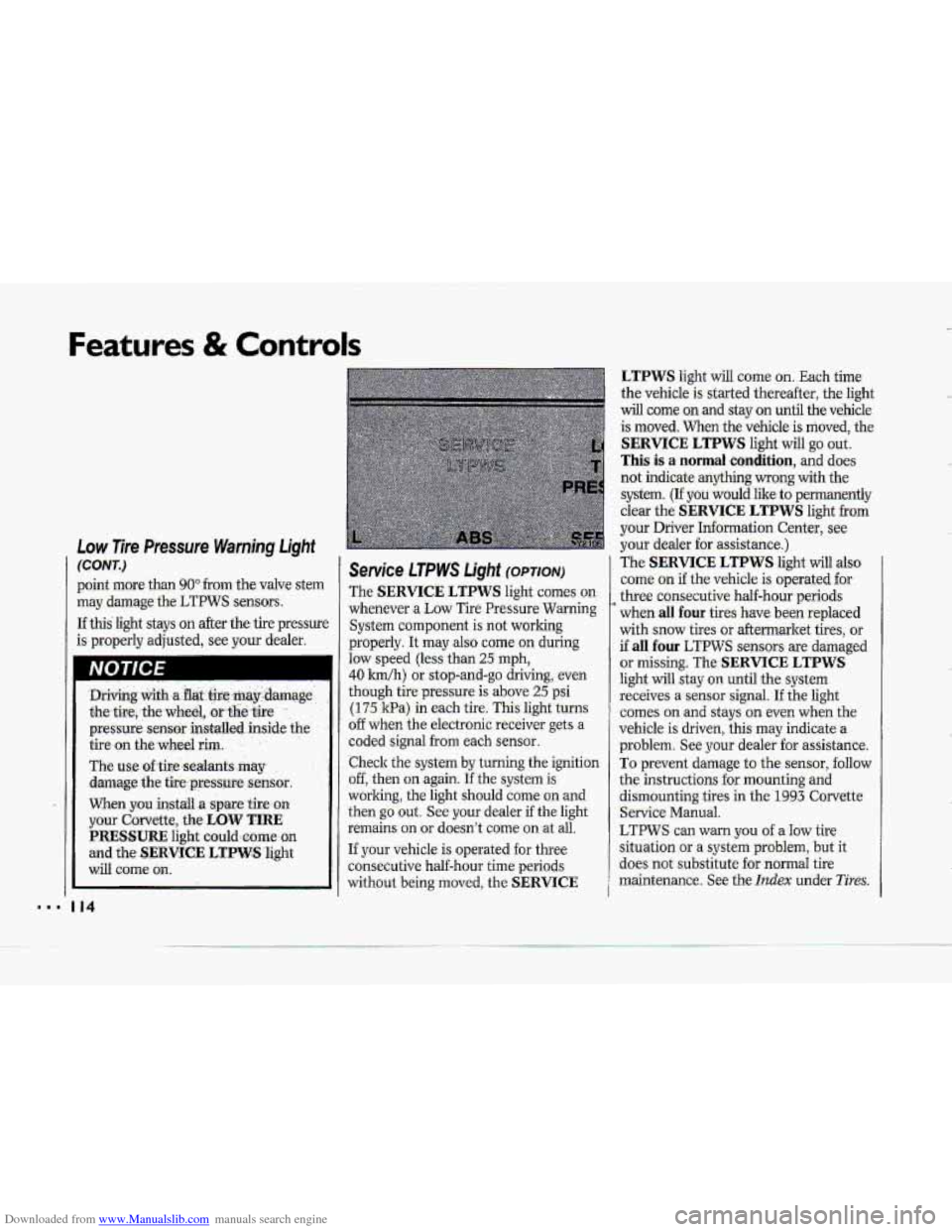
Downloaded from www.Manualslib.com manuals search engine Features & Contro1.s
point more than 90" from the valve stem
may damage the LTPWS sensors..
If this light stays on after the tire pressure
is properly adjusted, see your dealer.
I14
Service LTPWS Light (OPTION)
The SERVICE LTPWS light comes on
whenever a Low Tire PressureWrtming
System component is not working
properly. It
may also come on during
law speed (less than 25 rnph,
40 Idh) or. stop-and-go driving, even
though tire pressure is above 25 psi
(175 kPa-) in each tire. This light turns
o€f when the electronic receiver gets a
coded signal
from each sensor..
.Check the system
by turning the ignition
off, then on again. If'lhe system is
worling, the light should come on-and
then go out. See your dealer if the light
remains on
or doesn'.t come on .at ail.
If your vehicle is operated for three
consecutive half-hour time periods
without being moved,
the .. SERVICE
LTPWS light will come on. Each time
the vehicle
is started thereafter, the light
will come mand stay on until the vehicle.
is moved. When the vehicle
is moved, the-
SERVICE LTPWS light will go out.
This is a normal condition, and does
not indicate
anything-wrong with the
system.
(If you would Iilre to permanently
clear the
SERVICE LTPWS light from
your Driver Information Center, see
your dealer for assistance.)
The
SERVICE LTPWS light will also
corne. on if.the vehicle is operated for
three consecutive half-hour periods-
when
,dl four tires- have been replaced
with
snow tires or aftermarket tires, or
if all four LT-PWS sensors. are damaged
or missing. The SERVICE LTPWS
light will stay o.n until the system
receives
a sensor signal. I€ the light
'comes on and stays on even when the
vehicle is driven, this may .indicate
a
problem. See your dealer for assistance.
To prevent damage to the sensor, follow
the instructions
for mounting and
dismounting tires in
the 1993 Corvette,
Service Manua.1.
LTPWS can warn you of a Idw tire
situation-or
a system problem, but it
-does not substitute .foT.norrnal tire
maintenance. See the
Itzdex under Tires;
Page 175 of 370
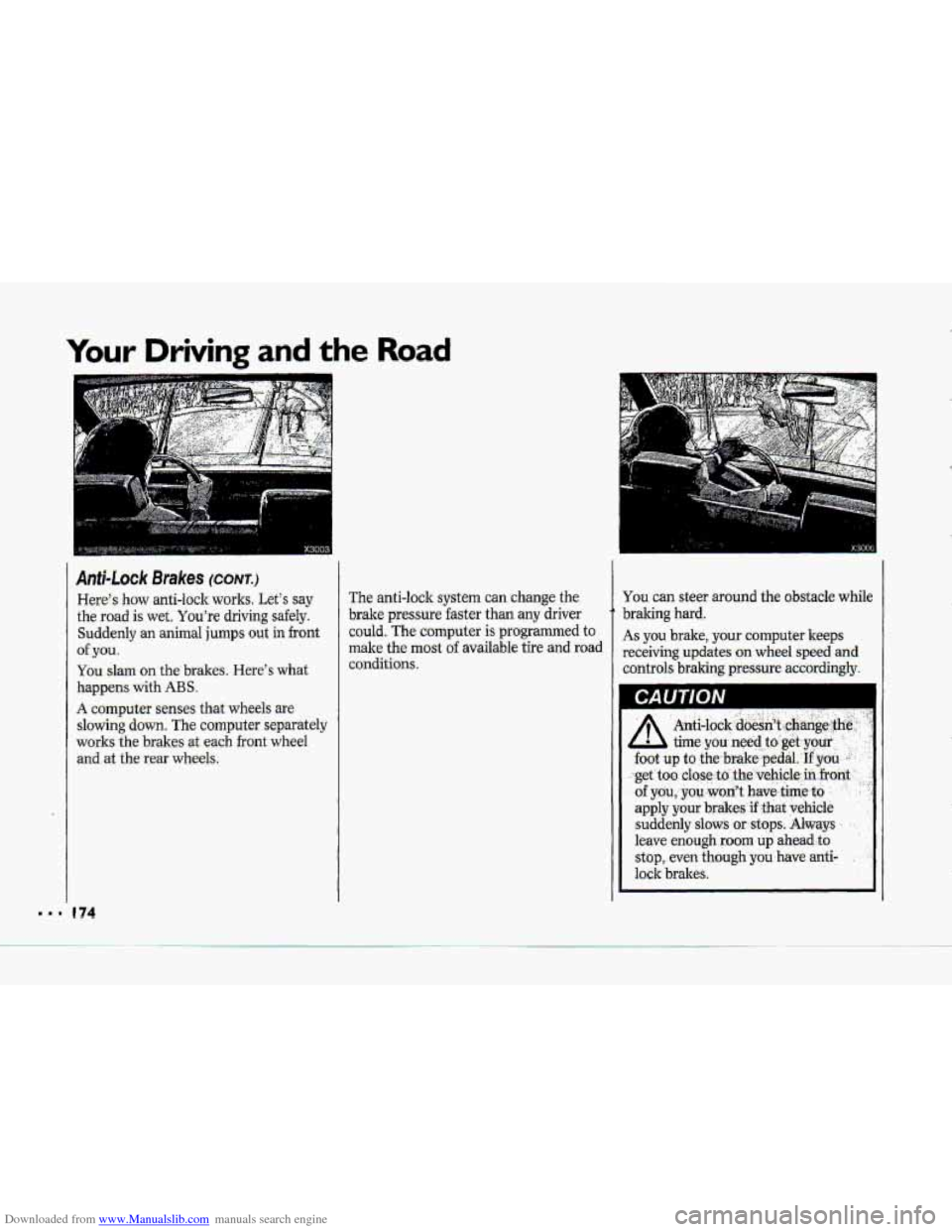
Downloaded from www.Manualslib.com manuals search engine Your Driving and the Road
L.l
Anfi-Lock Brakes (CONT.)
Here's haw anti-lock works. Let's say
the road is wet. You're driving safely.
Suddenly an animal jumps out in front
of ,you.
You slam on the brakes. ,Here's what
happens with ABS .
A computer senses that wheels are
slowing down. The computer separately
works
the brakesat each front wheel
and at the .rear wheels.
e 74
The anti-lock system can change the
brake pressure faster than
any driver
could. The computer
is programmed to
make the most of available tire alid road
conditions.
You can steer around the obstacle while
braking hard.
As you brake, your computer keeps
receiving
updates on wheel speed ad
controls braking pressure accordingly.
CAUTION
Page 189 of 370
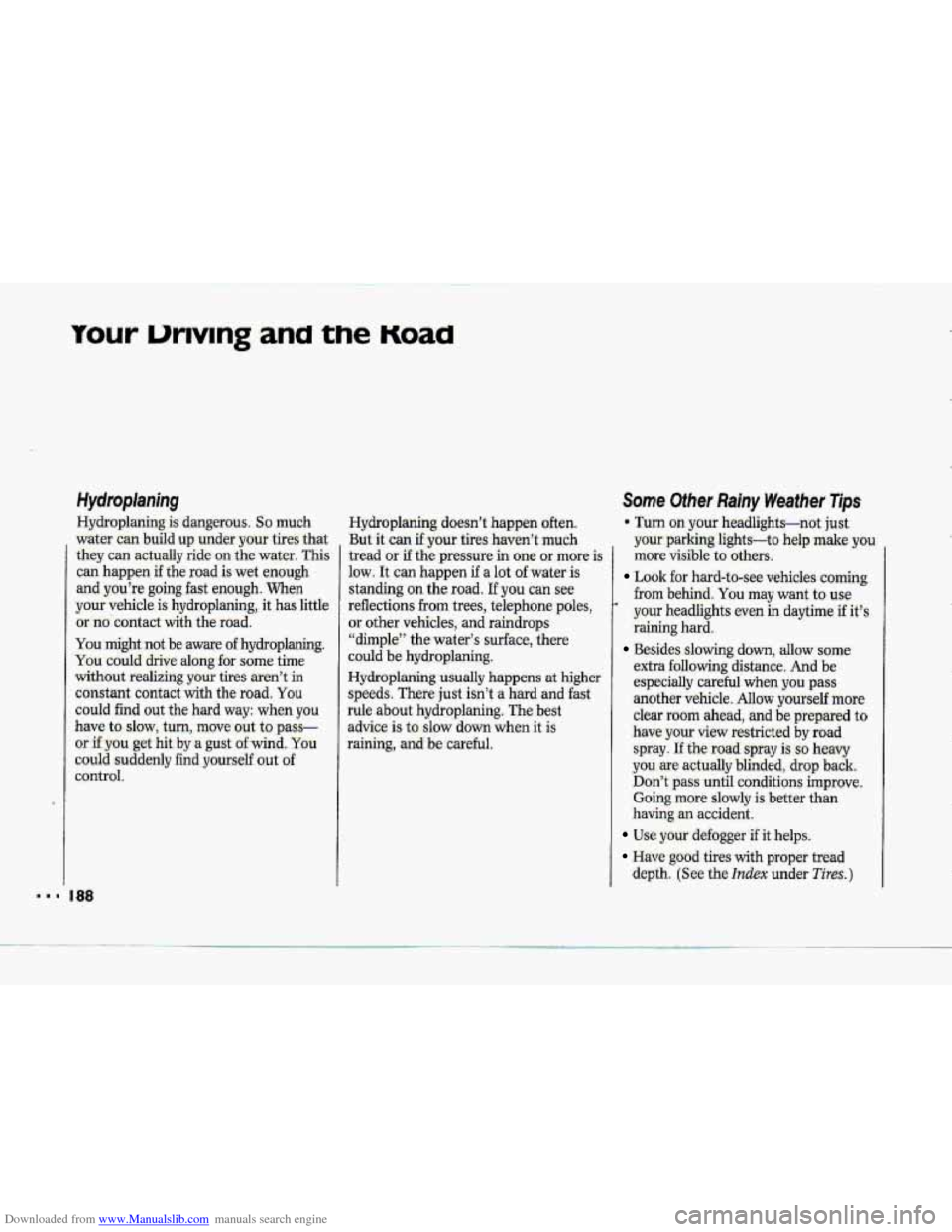
Downloaded from www.Manualslib.com manuals search engine your unvrng ana the Koad
‘I
Hydroplaning
Hydroplaning is dangerous. So much
water
can build up under your tires that
they can actually ride-on the-water. This
can happen
if the road is wet enough
and you’re going-fast enough. When
youi vehi-cle. is hydroplaning, it
has little
or no-contact with the road.
You
might. not be aware of hydroplaning.
You could drive along
for some time
without realizing your tires aren’t in
constant contact with the road.
You
could find out the hard way: when you
have to slow, turn, move out to pass-
or
if .you get hit by-a gust of wind. You
could suddenly find yours& out of
control.
I88
Hydroplaning doesn’t happen often.
But it can if your tires haven’t much
tread
or if the pressure in one or more is
low. It can happen if a lot of water- is
standing on the road.
If you can see
reflections
from trees, telephone poles,
or other vehicles, and raindrops
“dimple” the water’s surface, there
could be hydroplaning.
Hydrop1anhg:usually happens at higher
speeds. There just isn’t a hard and fast
rule about hydroplaning. The best
advice is
to slow down when it is
raining, and be careful.
Some Other Rainy Weather Tips
9 Turn on your headlights-not just
your
parking lights-to help make you
more visible to -others.
Look for hard-to-see vehicles co-ming
from behind.
You may want to use
your headlights even in daytime if it’s
-raining hard.
Besides slo.wing down, allow some
extra follo~ng distance.
And‘be
especially careful when you pass
another vehicle. Allow yourself-more clear room ahead, and be prepared
to
have your view restricted by r-oad .
spray. If the road. spray is.50 heavy
you..are actually blinded, drop back.
.Don’t pass until conditions improve.
Going more slowly
is better than
having-an accident.
Use your defogger if it helps.
Have good tires with proper tread
depth. (See
the Index under Tires.)
Page 194 of 370
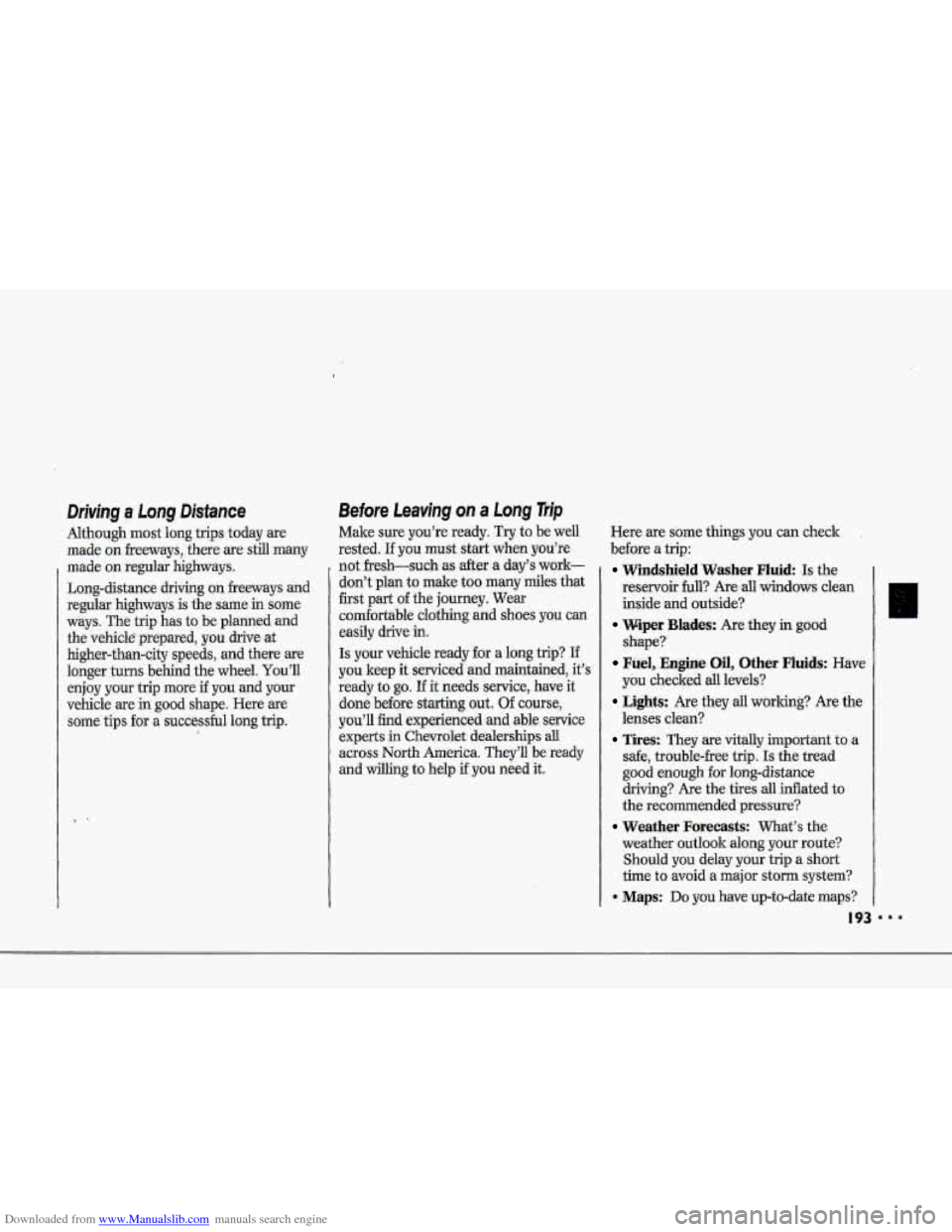
Downloaded from www.Manualslib.com manuals search engine I 9 II
!-
i
Driving a Long Distance
Although most long trips today are
made on freeways, there are still many
made
on regular highways.
Long-distance driving
on freeways and
regular highways is the same in some
ways. The trip has to be planned and
the vehicle prepared, you drive at
higher-than-city speeds, and there are
longer turns behhd the wheel. You’ll
enjoy your
trip more if you and your
vehicle
are in good shape. Here are
some.fips for
a successful long trip.
Before Leaving on a Long Trip
Make sure you’re ready. Try to be well
rested.
If you must start when you’re
not fresh-such as after
a day’s work-
don’t plan to
make too many miles that
first part of the journey. Wear
comfortable clothing and shoes you
can
easily drive in.
Is your vehicle ready for a long trip? If
you keep it serviced and maintained, it’s
ready to
go. If it needs service, have it
done before starting
out. Of course,
you’ll find experienced and able service
experts in Chevrolet dealerships all
across North America. They’ll be ready
and willing to help if you need it. Here
&e some
things you can check
before
a trip:
Windshield Washer Fluid: .Is the
reservoir full? Are ,all windows
clean
inside and outside?
shape?
you checked all levels?
lenses clean?
safe, trouble-hee trip. Is the tread
good enough for lofig-distance
drivhg? Are the tires all inflated to
the recammended pressure?
weather outlook
along your route?
Should you delay your trip a
short
time to avoid a major storm system?
0 Maps: Do you have up-to-date maps?
Wiper Blades: Are they in good
Fuel,, Enme Oil, Other Fluids: Have
Lights: Are they all working? Are the
Tires: They are vitally important to a
Weather Forecasts: What’s the
193
Page 199 of 370
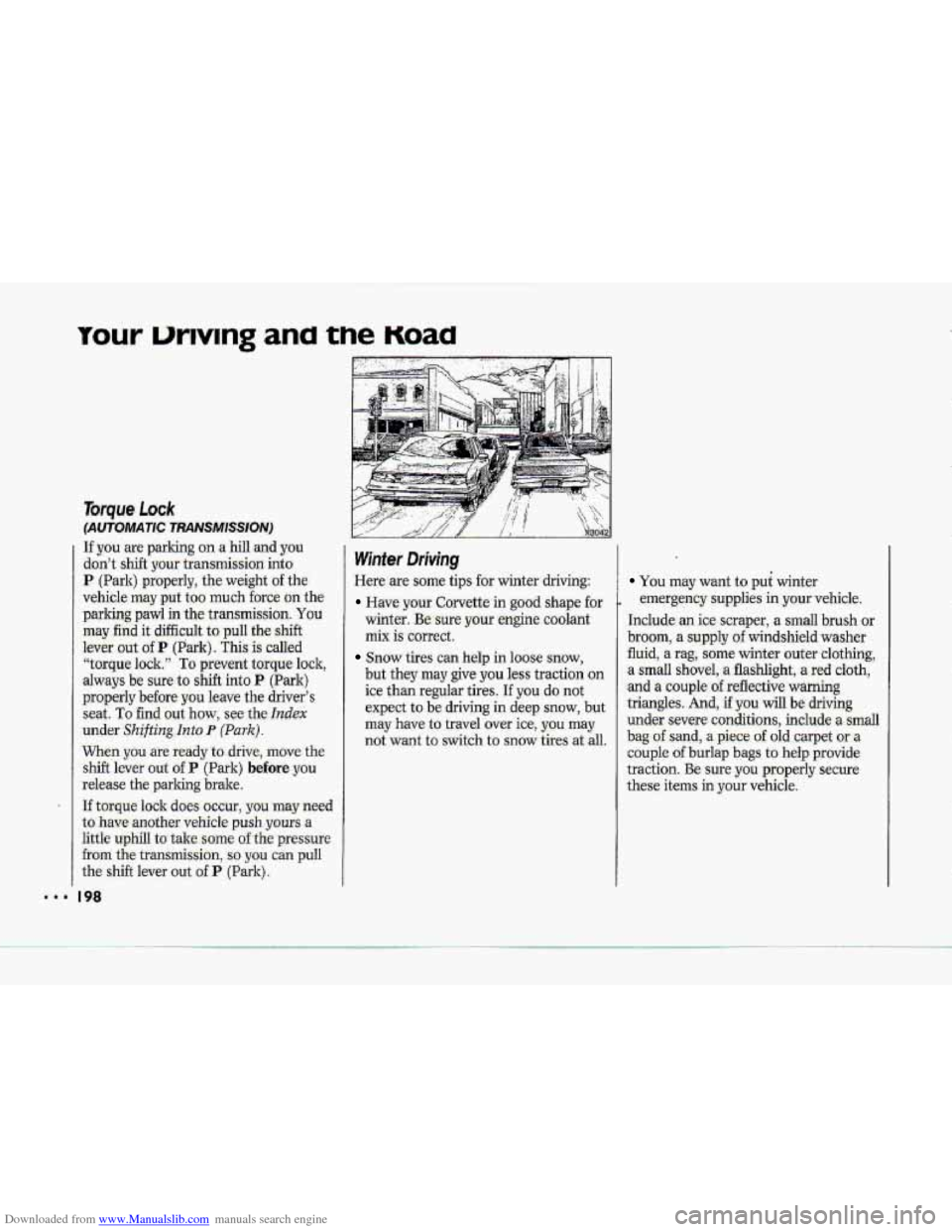
Downloaded from www.Manualslib.com manuals search engine your urlvlng ana tne Koaa
Torque Lock
(AUTQMATIC TRANSMISSION)
If you are parking on a hill and you
don’t shift your transmissian into
P (Park) properly, the weight of the
vehicle may put
too much force on the
parking pawl in the transmission. You
may find it difficult to pull the shift
lever out of
P (Ihrlr). This is called
“torque
lock.” To prevent torqu’e lock,
always
be sure to shift into P (Park)
properly before you leave the driver’s
seat.
To find out how, see the Index
under Shifting Into P (Park).
When you are ready to drive, move the
shift lever out
of P (Park) before you
release the parking brake.
If torque lock does occur, you may need
to. have another vehicle push yours a
little uphill to take some of-the pressure
from the transmiss.ion, ‘so you can pull
the
shifi lever out of P (Park).
I98
Winter Driving
Here are some tips for winter driving:
Have your Corvette in good shape for
winter.
Be sure your engine coolant
mix is correct.
Snow tires can help in loose snow,
but they may give you less traction on
ice than regular tires. If you do not
expect to be driving
in deep snow, but
may have
to travel over ice, you may
not want to switch to
snow tires at .all.
YOU may want to put winter
emergency supplies in your vehicle.
Include
an ice scraper, a small brush or
broom, a supply of windshield washer
fluid, a rag, some winter outer clothing,
a small shovel, a flashlight, .a red cloth,
and a couple of reflective warning
triangles. And, if-you will be driving
under severe conditions,
include a small
bag of sand, a piece of old carpet or a
couple of burlap bags to help provide
traction. Be sure you properly secure
these items in your vehicle.
Page 233 of 370
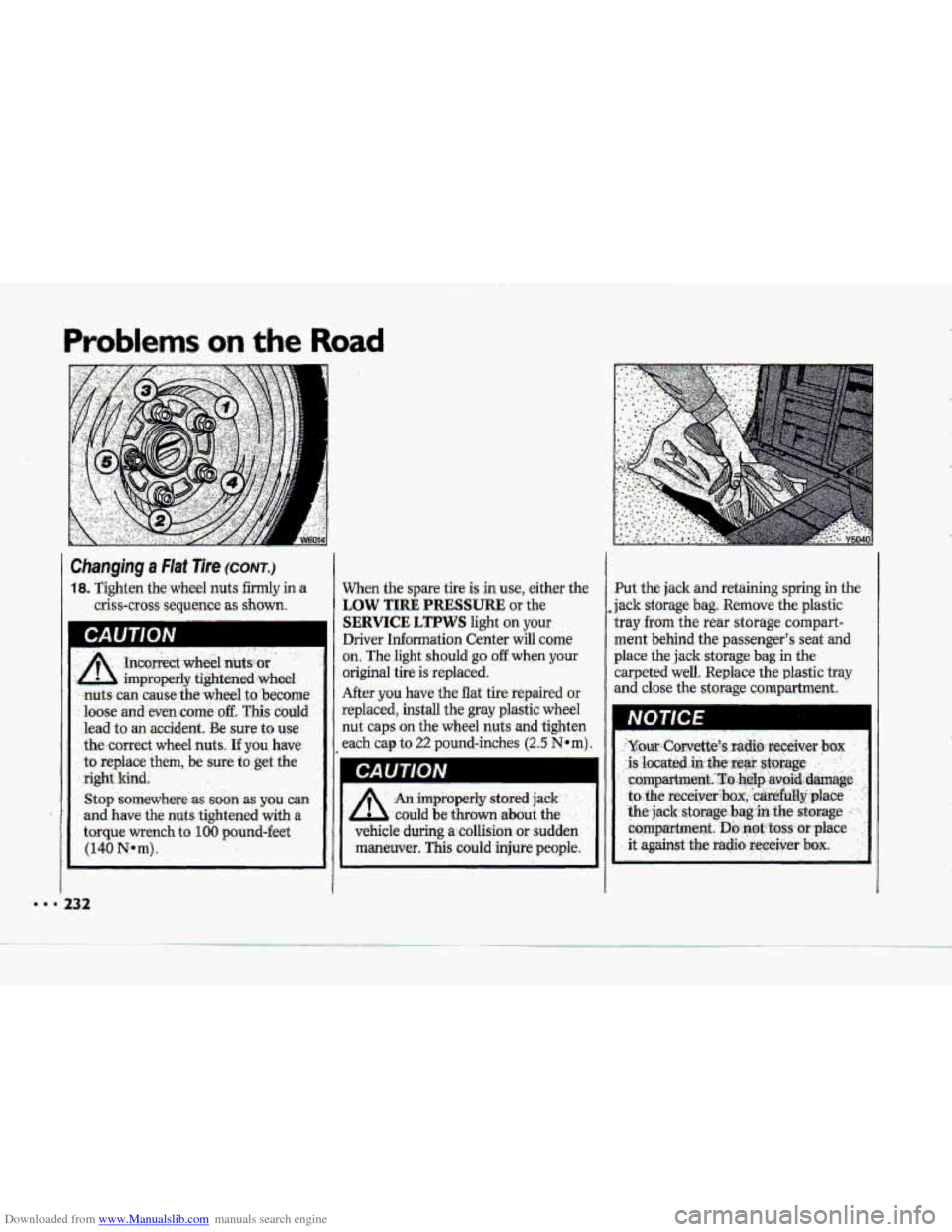
Downloaded from www.Manualslib.com manuals search engine aam
Problems on the Road
1
A
Changing a flat Tire (CONI-.)
18. Tighten the wheel nuts firmly in a
criss-cross sequence as shown.
,. .. .Wh& nbts: or, '
improperly. tighieried-wheel
'nuts-can cause ,the-wheel
to. become
loode and 'even-:come off.. This could
lead to a& .accident. Be .sure to use
,the ,correct
.wheel nuts. If you .have
to replace them, be sure to:get:the
Stop somewhere .as -soon
as you can
and have. the nuts tightened with a
torque wrench to
100 pound-feet
(140 N'* m) .
fight kind;'
232
When the spare tire is in use, either the
LOW TIRE PRESSURE or the
SERVICE LTPWS light on your
)river Information Center will come
In. The light should go off when your
triginal tire is replaced.
&er
you have the flat tire repaired or
eplaced, install the gray piastic'wheel
!ut
caps on the wheel nuts and tighten
ach cap to
22 pound-inches (2.5 Nom).
A ..
I
An improperly storid jack - .
--could bethrown abut the ..
vehicle.diring ai.collision or sudden
maneuver. This
could injure people.
CAUTION
Put-the jack and retaining spring in the
ack storage bag. Remove the plastic
:ray from the rear storage compart-
nent
behind the passenger's seat and
?lace the jack storage bag in the
:arpeted well. Replace the plastic tray
md close the storage compartment.
I NOTICE